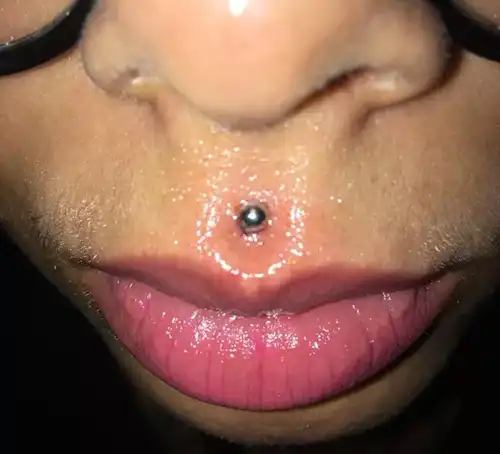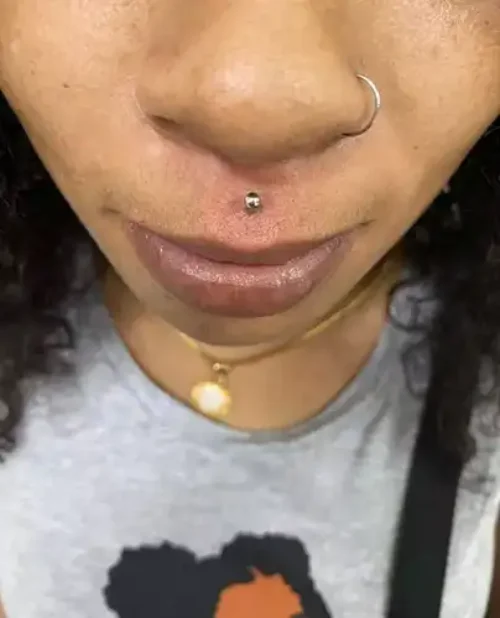Medusa Piercing in Nairobi, Kenya
A Medusa piercing, also known as a philtrum piercing, is a single piercing located in the center of the upper lip, just above the cupid’s bow, in the groove known as the philtrum. It’s a striking and symmetrical piercing that draws attention to your lips and smile — making it one of the most elegant and expressive facial piercings.
Medusa Piercing
Key Features of a Medusa Piercing
A Medusa piercing (also called a philtrum piercing) is one of the most distinctive and stylish facial piercings. It highlights your lips, facial symmetry, and smile — giving you a bold yet refined look. Below are the key features that define this piercing:
-
Placement
– The piercing is positioned in the center of the upper lip, directly below the septum and above the cupid’s bow, in the groove known as the philtrum.
– This central location makes it a symmetry-focused piercing, enhancing the natural balance of the face. -
Jewelry Type
– Typically fitted with a flat-back labret stud, which sits comfortably inside the mouth and prevents gum irritation.
– The visible part can be decorative, featuring gemstones, opals, or minimalist metal balls/discs.
– Most popular materials include titanium, surgical steel, and gold for safety and durability. -
Pain Level
– The Medusa piercing usually rates around 4–6 out of 10 on the pain scale.
– The philtrum area contains dense tissue, so the pain is quick and sharp but subsides rapidly after the piercing. -
Healing Time
– Average healing time is 8 to 12 weeks, depending on your skin type and aftercare routine.
– Initial swelling typically reduces within the first 5–7 days. -
Maintenance
– Requires consistent saline cleaning twice daily.
– You should also use an alcohol-free mouthwash after meals to maintain oral hygiene. -
Aesthetic Appeal
– Perfect for individuals who want a subtle yet expressive facial piercing.
– Pairs beautifully with other lip piercings like labret, Monroe, or Jestrum for a balanced, stylish look.
Medusa Piercing Procedure
Getting a Medusa (philtrum) piercing is a precise process that requires expertise and sterilization to ensure safety, comfort, and perfect placement. Here’s what to expect during the procedure:
- Consultation & Preparation
– Our piercer begins with a consultation to assess your lip anatomy, symmetry, and suitability for the piercing.
– You’ll choose your preferred jewelry type and material (usually titanium or surgical steel).
– Our piercer then ensures that all tools and jewelry are sterilized using an autoclave for maximum safety. - Marking the Placement
– Using a sterile marker, our piercer marks the center of your philtrum — the small groove above your upper lip and below your nose.
– You’ll be shown the marking in a mirror to confirm that the placement is symmetrical and matches your desired look. - Cleaning and Disinfection
– The area around the upper lip is thoroughly cleaned and disinfected to remove bacteria and oils.
– You may be asked to rinse your mouth with an alcohol-free mouthwash to ensure internal cleanliness. - Piercing Process
– A sterile, single-use hollow needle is used to make a small, precise puncture through the philtrum from the outside to the inside of the upper lip.
– Our piercer then quickly inserts the labret stud through the hole — with the flat disc resting inside the mouth and the decorative top outside. - Jewelry Insertion
– Initially, a slightly longer labret stud is used to accommodate swelling during the healing phase.
– After healing, you can switch to a shorter, fitted jewelry piece for comfort and aesthetics. - Cleaning and Aftercare Guidance
– Once the jewelry is secured, the piercer gently cleans the area again.
– You’ll receive detailed aftercare instructions, including cleaning methods, products to avoid, and signs of infection to watch for.
🕐 Total Time: The entire process typically takes 10–15 minutes, including preparation, piercing, and aftercare explanation.
Considerations Before Getting a Medusa Piercing
Before you book your Medusa (philtrum) piercing, it’s important to understand the factors that affect your comfort, healing, and long-term results. A Medusa piercing enhances your facial symmetry and smile — but it also requires proper anatomy, hygiene, and care.
Here’s what you should consider beforehand:
-
Lip and Facial Anatomy
– Not everyone’s lip shape or philtrum depth is ideal for this piercing.
– A professional piercer will examine your philtrum groove to determine if it can safely accommodate jewelry.
– If the area is too shallow or uneven, it may lead to improper placement or increased risk of migration. -
Oral Health and Hygiene
– Because this piercing is close to your mouth, good oral hygiene is essential.
– Brush your teeth twice daily, use an alcohol-free mouthwash, and avoid touching your lips with unclean hands.
– If you have gum disease, cavities, or cold sores, it’s best to resolve them before piercing. -
Gum and Tooth Sensitivity
– The back disc of the jewelry rests inside your mouth, so poor fitting or long jewelry can rub against gums or enamel, causing irritation.
– Always choose flat-back labret studs and have your piercer check the jewelry length after swelling goes down. -
Jewelry Quality
– Use only high-quality, hypoallergenic materials such as titanium, surgical steel, or 14K gold.
– Avoid cheap metals that may cause allergic reactions or tarnishing, especially since the piercing contacts saliva and skin. -
Pain Tolerance and Swelling
– Expect mild to moderate pain (around 4–6/10).
– Your upper lip will likely swell for 2–3 days, so schedule your appointment at a time when you can rest and heal comfortably. -
Lifestyle and Diet
– Avoid spicy, acidic, or hot foods for the first few days.
– If you smoke or drink alcohol, healing may take longer, so it’s advisable to limit or avoid these temporarily.
– Keep makeup, lip gloss, and skincare products away from the piercing site until fully healed. -
Professional Studio Selection
– Always visit a licensed and experienced piercing studio that follows strict sterilization protocols.
– Check reviews, cleanliness, and the piercer’s portfolio before committing.
– Ask if the studio provides aftercare support or follow-up visits. -
Commitment to Aftercare
– Healing requires consistent cleaning, patience, and discipline.
– If you can’t commit to daily aftercare, it’s best to postpone your piercing until you can.
💬 Tip: If you’re unsure about anatomy, jewelry size, or healing time, schedule a consultation first. Our reputable piercer will guide you through what’s safe and most flattering for your facial structure.

Medusa Piercing FAQ’s
Pain and Healing for a Medusa Piercing
Like any facial piercing, a Medusa (philtrum) piercing involves some pain and a healing process that requires patience and good hygiene. While the experience varies from person to person, understanding what to expect can help you prepare and heal comfortably.
Pain Level
- On a general pain scale, a Medusa piercing rates around 4–6 out of 10.
- The philtrum area contains dense tissue, so the piercing causes a sharp but quick sting that lasts only a few seconds.
- Most clients describe it as more of a pressure sensation than an intense pain.
Immediate Aftermath
- Expect swelling, redness, and tenderness within the first 24–48 hours.
- The upper lip may feel slightly tight or sore when smiling, eating, or speaking.
- Cold compresses or sipping cold water can help minimize swelling during the first few days.
Healing Time
- Initial healing: 6–8 weeks
- Full healing: 8–12 weeks
- Healing speed depends on your aftercare routine, overall health, and how often the piercing is disturbed.
Common Healing Stages
- Days 1–3 – Mild swelling, slight bruising, or tenderness; lips may feel tight.
- Days 4–14 – Crust may form around the piercing (normal sign of healing); swelling decreases.
- Weeks 3–6 – Discomfort subsides; tissue begins to strengthen internally.
- Weeks 8–12 – Fully healed if properly cared for; you may change to a shorter or decorative stud.
Healing Tips
- Clean the area twice daily with saline solution or a piercing aftercare spray.
- Use an alcohol-free mouthwash after meals to prevent bacteria buildup.
- Avoid spicy foods, alcohol, and smoking during the initial healing period.
- Don’t twist, play with, or change the jewelry until the piercing is fully healed.
- Sleep on your back if possible to avoid pressure on the piercing.
Signs of Proper Healing
- Minimal swelling or discharge after the first week.
- No more tenderness when moving your lips.
- Formation of a smooth tunnel around the jewelry.
When to Seek Professional Help
- Contact your piercer or a healthcare professional if you notice:
- Persistent swelling or pain beyond 10 days.
- Yellow or green discharge with an unpleasant odor.
- Hard lumps or migration (movement of jewelry from the original position).
Medusa Piercing Aftercare Guide
Proper aftercare is essential for a smooth and complication-free healing process after getting a Medusa (philtrum) piercing. Because this piercing sits close to the mouth, maintaining both external and oral hygiene is crucial. With the right care, you can prevent infections, reduce swelling, and enjoy a clean, healed piercing in just a few weeks.
-
Cleaning Routine
External Care (Outside the Lip)
– Clean the outer piercing area twice daily using a sterile saline solution or piercing aftercare spray.
– Gently dab around the jewelry with a cotton pad or sterile gauze — never twist or rotate the jewelry.
– Allow the area to air dry naturally or pat dry with a clean paper towel (avoid fabric towels).
Internal Care (Inside the Mouth)
– Rinse your mouth 3–4 times a day — especially after eating or drinking — using an alcohol-free, antibacterial mouthwash.
– Alternatively, you can rinse with warm saline water (¼ teaspoon of sea salt in a cup of warm water). -
What to Avoid During Healing
– Do not touch or twist the jewelry with your hands.
– Avoid spicy, hot, or acidic foods for the first few days to prevent irritation.
– Do not smoke, vape, or drink alcohol during early healing — these slow recovery and may cause infection.
– Refrain from kissing, oral sex, or contact with saliva from others until fully healed.
– Avoid makeup, lip gloss, or skincare products near the piercing area. -
Swelling and Discomfort Management
– Use cold compresses or sip chilled water to reduce swelling.
– Avoid salty or crunchy foods that can irritate the inner lip.
– Keep your head elevated when sleeping to minimize fluid buildup in the lip. -
Changing Your Jewelry
– Wait at least 8–12 weeks before changing your jewelry for the first time.
– Visit your piercer for the first jewelry downsizing — they’ll replace the longer starter stud with a shorter, fitted one to prevent gum or tooth irritation.
– Always use high-quality jewelry made from titanium, surgical steel, or gold.
Medusa Piercing Jewelry
Choosing the right jewelry for your Medusa (philtrum) piercing is just as important as the piercing itself. The correct jewelry ensures comfort, safe healing, and enhances your facial symmetry — while allowing you to express your personal style.
Common Jewelry Type: Labret Stud
The flat-back labret stud is the most popular and recommended jewelry for Medusa piercings. It’s designed for comfort and stability:
- The flat disc rests smoothly inside the mouth, reducing irritation to gums and teeth.
- The decorative top sits outside the upper lip, highlighting your smile.
- This design also minimizes movement, which helps promote faster healing.
Recommended Jewelry Materials
Choosing high-quality, hypoallergenic materials prevents allergic reactions and infections, especially since the piercing comes into contact with saliva and skin oils.
Material | Features | Suitability |
Titanium (Grade 23) | Lightweight, nickel-free, and corrosion-resistant. Ideal for sensitive skin. | Best for initial piercing |
Surgical Stainless Steel (316L) | Durable and affordable, with a shiny finish. | Common for both healing and healed piercings |
14K or 18K Gold | Elegant and long-lasting. Available in yellow, white, or rose tones. | Ideal for healed piercings |
Niobium | Hypoallergenic, smooth, and resistant to tarnish. | Safe alternative to titanium |
Bioplast or PTFE (Flexible Plastic) | Flexible, comfortable, and gentle on gums and teeth. | Great for active lifestyles or healing period |
Jewelry Sizes and Gauge
- Gauge (thickness): Typically 16G (1.2mm) or 14G (1.6mm) depending on anatomy.
- Length: The initial jewelry is slightly longer to allow for swelling — usually 8–10mm, later downsized to 6–8mm after healing.
- Always let your piercer measure and adjust jewelry to ensure proper fit and comfort.
Jewelry Top Styles
You can personalize your Medusa piercing with a variety of stylish tops:
- Classic Ball or Disc Tops – Minimalist and timeless.
- Gemstone or Opal Tops – Add sparkle and color for a subtle shine.
- Flat or Dome Tops – Smooth finish, ideal for comfort.
- Decorative Designs – Hearts, stars, spikes, or unique symbols for personality.
- Threadless Push-Pin Tops – Easy to change and more secure than threaded jewelry.
Jewelry Combinations and Stacking
- A Monroe or Labret piercing (to balance symmetry).
- A Jestrum piercing (directly below the Medusa, for a double-lip accent).
- Simple nose or septum piercings for a cohesive facial jewelry style.
For a bolder aesthetic, pair your Medusa piercing with:
Maintenance Tips for Jewelry
- Clean daily with saline solution during healing.
- Once healed, remove and clean jewelry periodically using mild soap and warm water.
- Avoid using alcohol, peroxide, or harsh cleaners on jewelry.
- Always wash your hands before touching or changing jewelry.
Cost of a Medusa Piercing in Nairobi, Kenya
When a client asks “How much for a Medusa piercing?”, here’s what contributes to the total cost:
Typical Price Breakdown
- Procedure / Labour – Piercer’s skill, time, needle, sterilization, studio set-up
- Jewelry (Basic vs Premium – Basic = titanium or surgical steel; Premium = gold, gemstones, custom top
- Hygiene / Sterilization – Autoclave use, single-use tools, clean environment
- Aftercare Products – Saline sprays/solutions, mouth rinses, cleaning supplies
- Follow-up / Downsizing Visits – Often needed after swelling subsides to adjust jewelry length
Price Tiers at Rebel Inks Tattoos, Tattoo Removal, and Body Piercings Parlour
To help you set clear expectations for clients (or set your own studio’s rates), here’s a tiered pricing table with realistic ranges in Kenya, depending on location (e.g. Nairobi vs smaller town), studio quality, and jewelry option.
Tier | Jewelry Quality | Expected Price Range (KES) | What’s Normally Included |
Low / Entry Level | Basic surgical steel or lower-end titanium | 1,500 – 2,500 | Piercing service + basic jewelry; minimal aftercare products; maybe little follow-up |
Mid-Range | Quality titanium or medical grade steel; maybe modest decorative top | 2,500 – 4,500 | Includes jewelry, basic aftercare, and usually a check-up/downsizing |
Premium | Solid gold / high grade titanium / custom tops | 4,500 – 7,500 | All service aspects (sterilization, premium jewelry, aftercare kit, professional follow-ups) |
⚠️ Possible Side Effects of a Medusa Piercing
While a Medusa (philtrum) piercing is generally safe when performed by a professional and cared for properly, it still involves piercing delicate tissue above the upper lip — which can sometimes lead to temporary or, in rare cases, more serious side effects. Being aware of these helps you take quick action and ensure smooth healing.
-
Swelling and Redness
– Mild swelling and redness are normal within the first few days after the piercing.
– The area may feel warm or tender but should gradually improve after 3–5 days.
– If swelling worsens or persists beyond a week, it may indicate irritation or infection. -
Pain and Tenderness
– Moderate pain is expected for the first few days.
– Prolonged or sharp pain might suggest trauma from touching, over-cleaning, or jewelry friction. -
Infection
– Poor hygiene or touching the piercing with unwashed hands can introduce bacteria.
– Signs include increased swelling, yellow/green discharge, bad odor, and throbbing pain.
– If you suspect infection, avoid removing the jewelry yourself — visit a professional piercer or healthcare provider. -
Gum and Tooth Irritation
– The inner flat disc of the jewelry can rub against gums or teeth, causing irritation or enamel wear over time.
– Downsizing to a shorter stud after healing helps prevent this issue.
– Using biocompatible materials like titanium or bioplast reduces irritation. -
Scarring and Bumps
– Improper cleaning, allergic reactions, or trauma can cause small hypertrophic scars or bumps around the piercing.
– Avoid popping or scratching them — consult your piercer for safe treatment. -
Jewelry Rejection or Migration
– In rare cases, the body may push the jewelry outward, causing migration or rejection.
– This can result from poor placement, low-quality jewelry, or excessive movement.
– Always use professional-grade jewelry and avoid unnecessary touching. -
Allergic Reactions
– Cheap metals (especially nickel) can trigger itchiness, rash, or swelling.
– Always choose hypoallergenic jewelry materials such as titanium, surgical steel, or 14K+ gold. -
Difficulty Eating or Speaking
– Swelling may temporarily affect lip movement, speech, or eating during the first few days.
– Stick to soft foods and avoid excessive talking or stretching of the lips while healing. -
Keloid Formation (Rare)
– Some individuals with sensitive skin or genetic predispositions may develop keloids or thick scars.
– If you notice an unusual lump that continues growing, seek medical advice early.
Get In Touch
For more information on the list above and any other special services,please call or come in for free consultation
Testimonials
After he pierced my industrial piercing and seeing his amazing work, I feel even more excited about getting my tattoo with him in January. I’m really looking forward to it!
I am extremely happy with my new 'Safari' tattoo from Eric at Rebel Inks! The quality of the artwork is fantastic. Eric is a true professional and an amazing artist.
The preparation and design process was thorough and collaborative. He was very patient with my specific requests, including making sure all the elements, which hold personal meaning, were perfect.
The service was friendly and highly professional from start to finish. Despite the 8-hour session, Eric was a pleasant person to spend the time with.
The aftercare guidance and follow-up have been excellent and careful, which has made the healing process easy and better than expected.
I highly recommend Eric for anyone looking for a thoughtful, talented, and caring tattoo artist.
I recommend them 💯
I would definitely recommend if you’re thinking of getting a piercing!
The staff were super friendly, explained everything clearly, and made me feel so at ease. They answered all my nervous questions (and I had many questions),
They walked me through the whole process, gave detailed aftercare instructions, and even followed up afterward to check how I was healing 🫶
Clean, professional, and full of good vibes.
Would 100% recommend . Definitely making a second trip here.
This was the second tattoo I got and I wish I could have come to Eric for my first one! He gave me really great after-care directions for the tattoo as well as a little jar of his own Vaseline-type stuff to put over my tattoo while it was healing! He even put second skin over my tattoo so that I didn’t have to worry about it for the first few days. Now THAT’S good service. My first tattoo artist didn’t do none of that lol.
After the session Eric didn’t rush me and my friend out, he chatted with us and even when he found out I was an artist too— really encouraged me to keep creating and to find a community of artists to support me. I almost cried because I’ve had such a hard time with my own art the past couple of years, it meant so much to me to have a fellow very talented artist say that to me. 🤍🤍🤍
Eric you’re amazing, don’t ever stop creating and just know you’ve impacted lives all over the world!🫶🏻 thanks so much for everything!!
From the moment I walked in, Eric was professional, welcoming, and attentive. He made sure I was comfortable throughout, provided everything I needed, and explained every step of the process. The tattooing itself was unbelievably smooth - I genuinely felt no pain compared to my previous tattoos over the last 22 years.
Eric also gave me excellent aftercare guidance and products, and thanks to that, my tattoo healed beautifully. The attention to detail, precision, and shading are absolutely stunning. This is hands-down the best tattoo I've ever had, and I will be flying back to Nairobi for any future ink.
If you want incredible art, a professional experience, and a talented artist who truly cares about his clients, Rebel Ink is the place to go!
From start to finish, the service was exceptional. The piercer was professional, knowledgeable, and made me feel completely comfortable. The cleanliness of the place was above and beyond — everything was spotless and hygienic, which really put me at ease. Highly recommend for anyone considering a piercing!
Shout out to Eric😘
We ended up changing the jewelry three times to ensure I had the best fit and avoided any signs of rejection, and he always listened to my suggestions as a client, which I really appreciated. Now, three months in, my piercing is healing beautifully, with no sign of rejection. Highly recommend for anyone who values a piercer who cares about your comfort and healing journey!
What stood out the most was the aftercare Eric checked in with me even three weeks later to see how the tattoo was healing. That kind of follow-up shows how much he truly cares about his work and his clients.
I’m very satisfied and will definitely be coming back for my next piece. Highly recommend!
The piercing wasn't as painful as I had thought and the process was quick and satisfactory. I love it!!!
The piercing is healing well thanks to the aftercare instructions and follow-up. I would highly recommend Rebel Inks
Eric also did a belly button piercing for a friend, guiding her through the process, doing the piercing and then explaining the after care to her.
The shop is on the 3rd floor, with the entrance to the stairs near an alleyway on the left. The shop is perfect size, clean, and attractive looking. The mural is pretty dope.
Thank you for the amazing service! 🔥👅✨
I got piercibgs there and the process was really good. My biggest concern was hygiene but that wasn't an issue at all, they use new needles and they sanitize them.
The service itself was also welcoming.
I was informes of everything i needed to know beforehand.
10/10 would recommend!
Eric was so calm and patient with my almost 2 year old lady. It was such a clean and hygienic process. We will definitely be back for our second rounds of piercings and maybe even another tattoo!
They assess the area before any art and advise one accordingly. They also give one post clean up process and also do a check up after the body art projects. Overall, I loved my experience and I’m hooked. 👍
Will definitely come back next time I’m in town 🙂
He listened to what I actually wanted and made sure he could fit in the time before I flew back home.
The shop is clean & private and is easy enough to find.
Eric has even checked in a couple of times since to make sure all is good.
I would totally recommend Eric! I absolutely love my Elephants!
I had a very easy healing period and always follow up from Eric to check on my progress...I would highly recommend if you are a first timer because from my experience all went very well and attention to detail
Thank you for a good job and looking forward to send all my friends your way
And all the best with the new year 2025!
From the moment I walked in, the staff was super friendly and made me feel at ease. The studio had a clean, professional atmosphere, which immediately put me at ease. My piercer was incredibly skilled and explained every step of the process, ensuring I was comfortable the entire time. The piercing was quick and practically painless, and the aftercare instructions were clear and easy to follow. I can tell they really care about the health and safety of their clients.
Overall, a fantastic experience—I highly recommend Rebel Inks and Tattoos for anyone looking to get pierced or tattooed!
They do follow up after their services
Eric's Studio isn’t just a place to get a tattoo—it’s an experience. The combination of professionalism, artistic talent, and a welcoming environment makes it a standout destination for anyone considering a tattoo.
I highly recommend Eric’s Studio to both first-timers and seasoned tattoo enthusiasts. If you’re looking for a high-quality tattoo and an enjoyable experience, this is the place to go.
I would definitely recommend their services again and again
Thank you Rebel Ink
My piercings are healing ❤️🩹 well
I would 💯 recommend
I will definitely come back for more .
Two, all the equipments he used for the piercings were new and/or sterilised.
Three, the parlour itself was very clean and was up to par with the hygiene standards.
Four, Eric provided effective aftercare instructions, making sure I knew exactly how to take care of my new piercings and he kept in touch and continues to do so, to check on the healing progress.
I highly highly highly recommend this place!!!
Would definitely recommend them to friends and go back for other piercings
Not only was the piercing process smooth, but he also provided thorough aftercare instructions, making sure I knew exactly how to take care of my new piercings. What really impressed me was that he keeps in touch to check on how the healing is progressing – a sign of true care for his clients.
The shop maintains a high standard of hygiene, and the atmosphere is welcoming and comfortable, which really added to the positive experience. I highly recommend this place to anyone looking for a professional and caring experience. I’ll definitely be coming back for any future piercings!
My appreciation for the excellent customer service I received. The follow-ups were prompt, and I truly appreciated the gentleness and professionalism throughout. Thank you!"
"Looking for professional eyebrow microshading removal? Look no further!"
The customer care is top tier 👌🏾👌🏾.
Wonderful place to get tattoos and piercings. 💯💯
Eric goes ahead to follow up on his clients progress and gives good advice each time I reach out to him.
I would recommend Reble tattoos anytime.
Good job bro we really appreciate.
Ohh and the price is very fair.
The environment was clean , procedure was sterile and the jewelry used are of the best quality.
He followed up with me during the healing process, he educated me on what I needed to do for my aftercare.
Eric is confident, skilled , experienced and the best piercer. Highly recommend Rebel inks.✨
Definitely recommend!
Great experience.
Eric definitely know what he is doing .
I got exactly what I wanted 2 tiny tats on the same finger .
He was kind and patient throughout the session.
Healing process has been good .
Aftercare services were given and regular checkups on the healing process were done.
I would 💯recommend.
Eric gave me the best reception as it was my first time there,and made me trust him all the way. I appreciate good services.
There services are also affordable not to forget 😊.
He was also invested in the aftercare and would ensure I follow the do's and don'ts in taking care of the tattoo and ensuring proper healing and maximum ink retention.
Would highly recommend Rebel Inks Tattoos.
Rebel Inks Tattoo offer the best,affordable and quality tattoo removal services.If you have unwanted ink,choose Rebel Inks Tattoo,they're the best of the best and the professionalism is a top notch.They ensure you're free from unwanted ink with their Laser Tattoo Removal Technology...
I did a Laser Tattoo Removal with them and i can attest they're the best....
Kudos Eric...
I highly recommend.
It was a generally good experience with good hygiene during the piercing process and has been a smooth healing process.... 10/10
tips. Highly recommend 👍🏽
100% recommendable.
I was particularly impressed with Eric's attention to hygiene. He thoroughly cleaned the room before I entered, sanitized all of the equipment he would be using, and changed gloves between each ear. This level of cleanliness gave me great confidence in his professionalism.
Eric's commitment to customer service did not end on the day of the piercing. He followed up with me regularly throughout the healing process to ensure that I was following the aftercare instructions and that my earlobes were healing properly.
I highly recommend Rebel Inks to anyone in Nairobi who is considering getting a piercing. Eric is a highly skilled and experienced piercer who takes great pride in his work.
So I Check all the boxes below and more:
Customer Care: ✔️
Professionalism : ✔️
Cleanliness ✔️
Price: ✔️
After care service ✔️
Thanks and good job, Eric
The place is neat and clean and the equipments he used were also fine standards. Really appreciate his following up with me on the healing 🤗
I WOULD HIGHLY RECOMMEND THEIR SERVICES to everyone. Actually what you see on their website is EXACTLY what you will get. Keep up the good work Rebel inks Tattoos.
The infection is now gone. I would definitely recommend!
Can recommend this place totally and would go back there anytime!
Thanks!
OUR LOCATION
Areas We Serve
NAIROBI
KIAMBU
KAJIADO
MACHAKOS
















































































































































































































